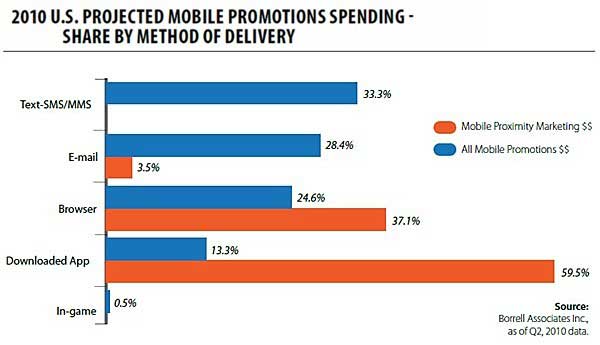Driven by increasing consumer adoption of mobile devices such as the smartphone and iPad, mobile proximity marketing is forecast to reach $760 million in 2011, and swell to nearly $6 billion by 2015, according to a report by Borrell Associates.
An estimated $200 million will be spent on mobile proximity marketing in 2010, almost entirely (97%) by large national companies that have retail stores in many markets. As proximity-based technologies begin to mature, smaller local businesses are expected to enter the market, helping to propel it to nearly 30 times its current size by 2015.

Mobile proximity marketing now accounts for a very small portion of overall mobile promotions spending—an estimated 7% in 2010. In 2011, that share will increase to 12.5%, and by 2015, proximity-based marketing will account for roughly 29% of all mobile marketing spending.
Below, other findings from the report titled Proximity-Based Marketing: Mobile Devices Untether Advertising from Media.
Disrupting Point-of-Purchase Ad Channels
Though still nascent, proximity-based marketing poses radical challenges to the mass media model of targeting large, aggregated local audiences—in favor permission-based offers to shoppers when they are physically near a purchase opportunity or other relevant location.
Moreover, there is a new retail audience that can only be reached via mobile: One-third of smartphone users who access retail information with their mobile devices are generally unreachable via other media channels (e.g., newspapers, yellow pages, TV), according to Millennial Media (August SMART report).
Looking for great digital marketing data? MarketingProfs reviewed hundreds of research sources to create our most recent Digital Marketing Factbook (May 2010), a 296-page compilation of data and 254 charts, covering email marketing, social media, search engine marketing, e-commerce, and mobile marketing. Also check out The State of Social Media Marketing, a 240-page original research report from MarketingProfs.
Mobile Promotions Spending by Delivery Method
Online promotions can be "delivered" to such mobile devices in a variety of ways. An estimated 33.3% of all mobile promotions in 2010 are delivered via test SMS/MMS accounts, while 13.3% are delivered via mobile applications. By contrast, 59.5% of mobile proximity promotions are delivered via apps.

Over one-third of proximity-based ads (37.1%) are delivered via mobile Web browser, and just 3.5% are delivered via email.
About the data: Findings are from the Proximity-Based Marketing report, the third in a series of three reports on mobile marketing by Borrell Associates.



